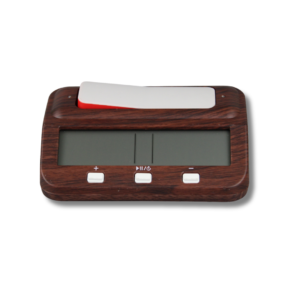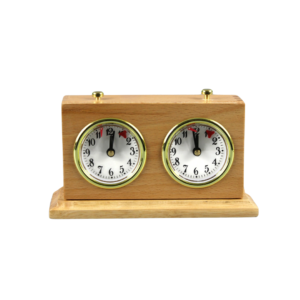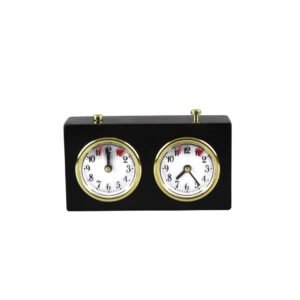Chess Clocks
A chess clock is an essential tool in competitive chess. It ensures that the game progresses at a fair pace, preventing players from taking too long with their moves. By tracking time, chess clocks introduce an element of urgency and strategy into the game, influencing the way players approach each move. Whether you’re a beginner or an experienced player, understanding how chess clocks work and the different types available can significantly enhance your chess-playing experience.
In this comprehensive guide, we will delve into the different types of chess clocks, how they function, and the differences between digital and analogue models.
What is a Chess Clock?
A chess clock is a time-keeping device used in chess to regulate the amount of time each player has to make their moves. It ensures that the game is played within a set timeframe, preventing one player from taking too long while the other is left with little time to think. Each player’s clock starts when it is their turn to move, and the clock stops once the player presses a button to pass the turn to their opponent.
Chess clocks come in various designs and styles, but their primary function is to manage time limits for both players. Chess clocks can be used in casual games, tournaments, or for online play to simulate time controls.
The Function of a Chess Clock
The main purpose of a chess clock is to keep track of time and ensure that each player adheres to the designated time control. This introduces a strategic element to the game, where players must make decisions not only based on the game’s position but also considering their remaining time. Time pressure can significantly impact the quality of moves, making the game more dynamic and engaging.
Key Functions of a Chess Clock:
- Time Control: The most important function of a chess clock is to regulate the time available to each player. This helps ensure that the game moves along at a reasonable pace and prevents players from taking excessive time on individual moves. There are various time control options available, such as:
- Classical Time Control: Each player is allotted a specific amount of time to make all of their moves (e.g., 90 minutes for the entire game).
- Increment: Time is added to the player’s clock after each move, allowing them extra time to think as the game progresses.
- Blitz: Both players are given very limited time, often just a few minutes each, for the entire game.
- Rapid: Players are allotted more time than in blitz games, usually between 10 and 25 minutes per player.
- Armageddon: In this form, one player has slightly more time than the other (usually 5 minutes for one player and 4 minutes for the other), and it is used as a tiebreaker.
- Fair Play: The clock ensures that no player is given an unfair advantage by forcing them to make moves within the same time constraints. It makes the game more competitive and fair, ensuring both players have the same amount of time to think through their moves.
- Pacing the Game: Chess clocks are a great way to regulate the pacing of the game. This helps players manage their time effectively, avoiding long delays between moves and maintaining the flow of the game.
How a Chess Clock Works
Chess clocks typically consist of two clocks side by side, one for each player. When it is a player’s turn, their clock runs while the opponent’s clock is stopped. Once the player makes a move and presses the clock, it stops, and the opponent’s clock starts running.
Basic Mechanism:
- Starting the Clock: When a game begins, both clocks are set to the agreed-upon time control. A signal, such as a button press or a lever, is used to start the first player’s clock.
- Switching Turns: After each move, the player presses their side of the clock to stop their time and activate the opponent’s time. This ensures that both clocks run alternately, switching with every turn.
- Running Out of Time: If a player’s time runs out, they automatically lose the game, unless they have a checkmate position or a draw position already established on the board. However, in some game formats, such as blitz or rapid, the game may continue until checkmate is achieved, despite the time running out.
- Finishing the Game: The game ends when a player wins (checkmate), draws (stalemate, insufficient material, or agreement), or loses due to running out of time.
Now that we’ve covered how a chess clock works, let’s explore the two main types of chess clocks: analogue and digital.
Types of Chess Clocks: Analog vs Digital
1. Analog Chess Clocks
Analog chess clocks, often referred to as mechanical clocks, are the traditional type of clock used in chess. These clocks work with gears and dials, providing a classic look and feel.
How Analog Clocks Work:
- Analog clocks consist of two separate time dials (one for each player), each with a minute hand and a second hand. The clocks are powered by a winding mechanism, which allows the hands to move forward as time passes.
- The clocks are generally activated by pressing a button or lever to switch from one clock to the other.
- As the player’s clock runs, the minute hand moves forward. When the player presses the button to stop their clock, the opponent’s clock begins to run.
Features of Analog Clocks:
- Simplicity: Analog clocks are relatively simple to use and do not require any special setup or battery power. They are often considered more intuitive for players who enjoy the tradition of chess.
- Physical Mechanism: The movement of the clock’s hands gives a physical, tactile representation of time passing. This can be psychologically motivating, as players can physically see how their time is running down.
- Classic Aesthetic: Many chess enthusiasts appreciate the nostalgic look of analogue clocks, especially those with decorative features or vintage designs.
Drawbacks of Analog Clocks:
- Limited Functionality: Analog clocks typically only allow for basic time settings (e.g., a simple timer with a minute and second dial). They often lack more advanced features like increment or delay settings, which digital clocks can offer.
- No Time Reset: With analogue clocks, once a player’s time runs out, the clock cannot be reset to a specific time if needed. This can be limiting for tournaments with complex time controls.
- Prone to Mechanical Issues: Analog clocks rely on mechanical components, which can malfunction over time or become inaccurate if not properly maintained.
2. Digital Chess Clocks
Digital chess clocks offer more advanced features and precise timekeeping. They are powered by batteries or electricity and can be programmed with more complex time control settings, making them ideal for modern tournaments.
How Digital Clocks Work:
- Digital clocks use a digital display to show the elapsed time for each player. Time is counted in seconds and minutes, and players start their clock by pressing a button, just as with analogue clocks.
- Digital clocks typically allow for a variety of time controls, such as blitz, rapid, or classical formats, and can include features like increment (adding time after each move) and delay (pausing the clock for a set period before counting down).
Features of Digital Clocks:
- Multiple Time Controls: Digital clocks allow for various time settings, such as adding extra time after each move (increment), setting delays before the clock starts counting, and adjusting for complex tournament time limits.
- Precision: Digital clocks offer much more accurate timekeeping than analogue clocks. They also offer the ability to easily reset or adjust time during games or tournaments.
- Visual Display: The time is shown on an easy-to-read digital screen, which is particularly useful in tournaments with high-pressure time controls.
- Multiple Functions: Many digital clocks offer functions like alarms, time warning signals, and the ability to adjust settings for various time control formats.
Drawbacks of Digital Clocks:
- Complexity: Digital clocks may require a little more effort to learn, as players must become familiar with the settings and features. For beginners, it can be overwhelming to adjust the controls or change the time settings.
- Dependence on Power: Digital clocks require batteries or electricity to function. If the power source runs out, the clock may stop working. Analog clocks, on the other hand, can continue functioning without electricity.
- More Expensive: High-quality digital clocks, especially those used for tournament play, can be more expensive than traditional analogue models.
Which Chess Clock is Right for You?
Choosing the right chess clock depends on your playing style and needs. Here’s a quick breakdown to help you decide:
- Analogue Chess Clocks: Ideal for traditionalists who appreciate a classic aesthetic and the simplicity of mechanical clocks. They are perfect for casual play and are often more affordable.
- Digital Chess Clocks: Best suited for tournament play, professional chess players, or those who require specific time control features like increment or delay. They are more versatile, offering various time settings and precise timekeeping.
Conclusion
A chess clock is an indispensable tool for any serious chess player. Whether you’re playing casually with friends or competing in tournaments, a chess clock ensures that the game progresses smoothly and within the designated time limits. By understanding the different types of chess clocks, how they work, and their unique features, you can select the perfect clock that complements your playing style.
Whether you choose an analogue or digital clock, investing in a reliable and functional timepiece will undoubtedly enhance your






